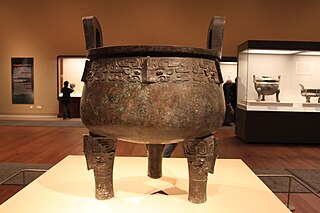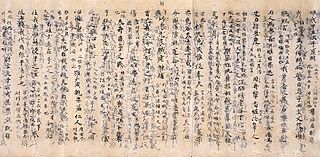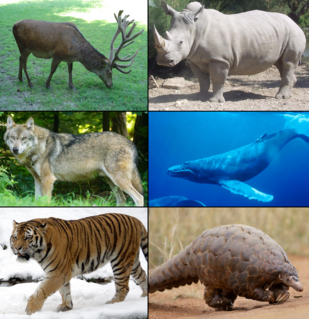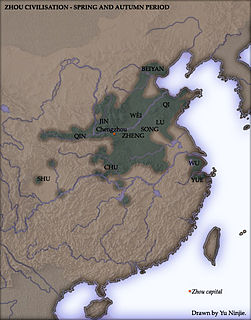
The Zhou dynasty was a Chinese dynasty that followed the Shang dynasty and preceded the Qin dynasty. The Zhou dynasty lasted longer than any other dynasty in Chinese history. The military control of China by the royal house, surnamed Ji, lasted initially from 1046 until 771 BC for a period known as the Western Zhou and the political sphere of influence it created continued well into the Eastern Zhou period for another 500 years.

The Shang dynasty, also historically known as the Yin dynasty, was a Chinese dynasty that ruled in the middle and lower Yellow River valley in the second millennium BC, succeeding the Xia dynasty and followed by the Zhou dynasty. The classic account of the Shang comes from texts such as the Book of Documents, Bamboo Annals and Records of the Grand Historian. According to the traditional chronology based on calculations made approximately 2,000 years ago by Liu Xin, the Shang ruled from 1766 to 1122 BC, but according to the chronology based upon the "current text" of Bamboo Annals, they ruled from 1556 to 1046 BC. The Xia–Shang–Zhou Chronology Project dated them from c. 1600 to 1046 BC based on the carbon 14 dates of the Erligang site.

Zhou Enlai, Wade-Giles transliteration Chou En-lai, was the first Premier of the People's Republic of China. From October 1949 until his death in January 1976, Zhou was China's head of government. Zhou served under Chairman Mao Zedong and helped the Communist Party rise to power, later helping consolidate its control, form its foreign policy, and develop the Chinese economy.

The Long March was a military retreat undertaken by the Red Army of the Communist Party of China, the forerunner of the People's Liberation Army, to evade the pursuit of the Kuomintang army. There was not just one Long March, but a series of marches, as various Communist armies in the south escaped to the north and west. The best known is the march from Jiangxi province which began in October 1934 and ended in Yan'an, Shaanxi province in October 1935. The First Front Army of the Chinese Soviet Republic, led by an inexperienced military commission, was on the brink of annihilation by Generalissimo Chiang Kai-shek's troops in their stronghold in Jiangxi province. The Communists, under the eventual command of Mao Zedong and Zhou Enlai, escaped in a circling retreat to the west and north, which reportedly traversed over 9,000 kilometres (5,600 mi) over 370 days. The route passed through some of the most difficult terrain of western China by traveling west, then north, to Shaanxi.

The Xi'an Incident was a political crisis that took place in Xi'an, Republic of China in 1936. Chiang Kai-shek, leader of the Republic of China, was detained by his subordinates Generals Chang Hsüeh-liang and Yang Hucheng, in order to force the ruling Chinese Nationalist Party to change its policies regarding the Empire of Japan and the Communist Party of China (CPC).

The Spring and Autumn period was a period in Chinese history from approximately 771 to 476 BCE which corresponds roughly to the first half of the Eastern Zhou period. The period's name derives from the Spring and Autumn Annals, a chronicle of the state of Lu between 722 and 479 BCE, which tradition associates with Confucius.

The Western Zhou was the first half of the Zhou dynasty of ancient China. It began when King Wu of Zhou overthrew the Shang dynasty at the Battle of Muye and ended when the Quanrong nomads sacked its capital Haojing and killed King You of Zhou in 771 BC.

Oracle bone script was an ancestor of modern Chinese characters engraved on oracle bones—animal bones or turtle plastrons used in pyromantic divination—in the late 2nd millennium BC, and is the earliest known form of Chinese writing. The vast majority, amounting to over 50,000 inscribed items, were found at the Yinxu site located in Xiaotun Village, Anyang City, Henan Province. They record pyromantic divinations of the last nine kings of the Shang dynasty, beginning with Wu Ding, whose accession is dated by different scholars at 1250 BC or 1200 BC. After the Shang were overthrown by the Zhou dynasty in c. 1046 BC, divining with milfoil became more common, and a much smaller corpus of oracle bone writings date from the Western Zhou. Thus far, no Zhou sites have been found with a cache of inscriptions on the same scale as that at Yinxu, although inscribed oracle bones appear to be more widespread, being found near most major population centers of the time, and new sites have continued to be discovered since 2000.

Chinese bronze inscriptions, also commonly referred to as bronze script or bronzeware script, are writing in a variety of Chinese scripts on ritual bronzes such as zhōng bells and dǐng tripodal cauldrons from the Shang dynasty to the Zhou dynasty and even later. Early bronze inscriptions were almost always cast, while later inscriptions were often engraved after the bronze was cast. The bronze inscriptions are one of the earliest scripts in the Chinese family of scripts, preceded by the oracle bone script.
Dynasties in Chinese history, or Chinese dynasties, were hereditary monarchical regimes that ruled over China during much of its history. From the inauguration of dynastic rule by Yu the Great in circa 2070 BC to the abdication of the Xuantong Emperor on 12 February 1912 in the wake of the Xinhai Revolution, China was ruled by a series of successive dynasties. Dynasties of China were not limited to those established by ethnic Han—the dominant Chinese ethnic group—and its predecessor, the Huaxia tribal confederation, but also included those founded by non-Han peoples.

The Book of Documents or Classic of History, also known as the Shangshu, is one of the Five Classics of ancient Chinese literature. It is a collection of rhetorical prose attributed to figures of ancient China, and served as the foundation of Chinese political philosophy for over 2,000 years.

Lu was a vassal state during the Zhou dynasty of ancient China located around modern Shandong province. Founded in the 11th century BC, its rulers were from a cadet branch of the House of Ji (姬) that ruled the Zhou dynasty. The first duke was Boqin, a son of the Duke of Zhou, who was brother of King Wu of Zhou and regent to King Cheng of Zhou.

The Northern Zhou followed the Western Wei, and ruled northern China from 557 to 581 AD. The last of the Northern Dynasties of China's Northern and Southern dynasties period, it was eventually overthrown by the Sui Dynasty. Like the preceding Western and Northern Wei dynasties, the Northern Zhou emperors were of Xianbei descent.
Kong Zhou, courtesy name Gongxu, was an official and minor warlord who lived during the Eastern Han dynasty of China.

King Wen of Zhou was Count of Zhou during the late Shang dynasty in ancient China. Although frequently confused with the Duke of Zhou, also known as "Lord Zhou", they are different historical personalities. Although it was his son Wu who conquered the Shang following the Battle of Muye, Count Wen was posthumously honored as the founder of the Zhou dynasty and titled King. Many of the hymns of the Classic of Poetry are praises to the legacy of King Wen. Some consider him the first epic hero of Chinese history.

Zhou Tong was the archery teacher and second military arts tutor of famous Song dynasty general Yue Fei. Originally a local hero from Henan, he was hired to continue Yue Fei's military training in archery after the boy had rapidly mastered spearplay under his first teacher. In addition to the future general, Zhou accepted other children as archery pupils. During his tutelage, Zhou taught the children all of his skills and even rewarded Yue with his two favorite bows because he was his best pupil. After Zhou's death, Yue would regularly visit his tomb twice a month and perform unorthodox sacrifices that far surpassed that done for even beloved tutors. Yue later taught what he had learned from Zhou to his soldiers and they were successful in battle.

Ferungulata or Fereuungulata is a clade of placental mammals that groups together various carnivorans, pangolins and ungulates. It has existed in two guises, a traditional one based on morphological analysis and a revised one taking into account more recent molecular analyses.

Zhou Peiyuan was a Chinese theoretical physicist and politician. He served as president of Peking University, and was an academician of the Chinese Academy of Sciences (CAS).

The I Ching or Yi Jing, usually translated as Book of Changes or Classic of Changes, is an ancient Chinese divination text and among the oldest of the Chinese classics. Originally a divination manual in the Western Zhou period (1000–750 BC), over the course of the Warring States period and early imperial period (500–200 BC) it was transformed into a cosmological text with a series of philosophical commentaries known as the "Ten Wings". After becoming part of the Five Classics in the 2nd century BC, the I Ching was the subject of scholarly commentary and the basis for divination practice for centuries across the Far East, and eventually took on an influential role in Western understanding of Eastern thought.

The Eastern Zhou was the second half of the Zhou dynasty of ancient China. It was divided into two periods: the Spring and Autumn and the Warring States.


















